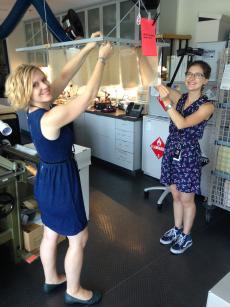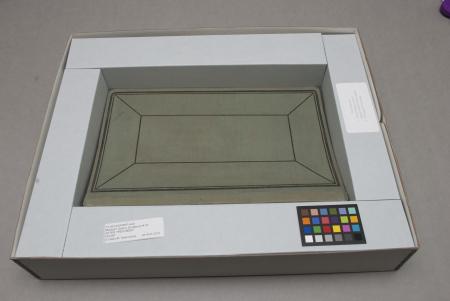 This summer, Sarah Casto and I interned through a partnership of the Archives of American Art (AAA) and Smithsonian Institution Archives (SIA). Our project to stabilize the Macbeth Gallery Scrapbooks, a collection of twenty scrapbooks in the collection of AAA, was generously funded by The Smithsonian Women’s Committee. More can be read about the history of the scrapbooks and the valuable information they contain here. Under the supervision of SIA’s senior conservator Nora Lockshin and AAA registrar Susan Cary, Sarah and I were presented with the unique challenge of working primarily in an office at AAA rather than in a conservation lab. We employed our ingenuity to make the simple office into a functioning pop-up lab, our "conservation station."
This summer, Sarah Casto and I interned through a partnership of the Archives of American Art (AAA) and Smithsonian Institution Archives (SIA). Our project to stabilize the Macbeth Gallery Scrapbooks, a collection of twenty scrapbooks in the collection of AAA, was generously funded by The Smithsonian Women’s Committee. More can be read about the history of the scrapbooks and the valuable information they contain here. Under the supervision of SIA’s senior conservator Nora Lockshin and AAA registrar Susan Cary, Sarah and I were presented with the unique challenge of working primarily in an office at AAA rather than in a conservation lab. We employed our ingenuity to make the simple office into a functioning pop-up lab, our "conservation station."
Scrapbooks are known within archives and libraries for the range of challenges they present as objects, and the American Institute of Conservation (AIC) Book and Paper Group has assembled reference materials about the conservation of scrapbooks in a wiki. The Macbeth Gallery Scrapbooks are a series of commercially produced scrapbooks of varying type and condition, and they primarily contain newspaper clippings and other items related to the gallery. Our initial survey of the scrapbooks revealed inherently brittle wood-pulp paper pages, many of which cracked at our touch, as well as failed adhesives, leaving loose clippings and gallery catalogs.
 With the conditions of the scrapbooks ranging from fully intact to entirely disbound (with all pages separated from the book's original binding), we found that some books remained only tenuously intact. Simply turning pages resulted in pages cracking away from the binding, so laying the book flat to image the pages for digitization would have been impossible. We determined with our supervisors that the best thing for five of the scrapbooks was to purposefully disbind them, storing the loose pages in folders with buffered interleaving papers. To stabilize the scrapbooks, Sarah and I needed to clean the pages, readhere all loose items, reinforce and repair torn pages with adhesive and paper, consolidate covers, collate pages, and rehouse the collection.
With the conditions of the scrapbooks ranging from fully intact to entirely disbound (with all pages separated from the book's original binding), we found that some books remained only tenuously intact. Simply turning pages resulted in pages cracking away from the binding, so laying the book flat to image the pages for digitization would have been impossible. We determined with our supervisors that the best thing for five of the scrapbooks was to purposefully disbind them, storing the loose pages in folders with buffered interleaving papers. To stabilize the scrapbooks, Sarah and I needed to clean the pages, readhere all loose items, reinforce and repair torn pages with adhesive and paper, consolidate covers, collate pages, and rehouse the collection.
 Before we could begin treatment, we had to carefully select the best combinations of adhesive and paper to use for repairing the scrapbooks. The traditional method of paper repair - Japanese paper applied with wheat starch paste and dried under weight - was not feasible for this project for a large percentage of the albums due to their extremely brittle state and time constraints. These weakened papers do not always respond well to the stresses of mending even with extremely careful application, wetting and drying – new breaks can result at repair boundaries where the binding is restrained, or where pages are turned at corners, as example. Sarah and I were faced with twenty scrapbooks, and our ultimate goal was stabilization for digitization, not full conservation treatment, so we needed a more efficient method for mending. Thus, we turned to solvent-set and heat-set tissues. Sarah and I made our own mending tissues, turning to shared and tested methods within the conservation community. We spent several days experimenting with different adhesives and application methods, adapting as needed based on trial and error. We found the most satisfaction with a variety of weights of handmade papers, prepared with Avanse MV 100 and Plextol B 500, a mixture formulated and tested by conservators at the National Archives and Records Administration because it is heat-set and it requires no drying time when applied. This allowed us to rapidly increase the pace of our work. For loose items, where original placement was verifiable, we applied wheat starch paste where possible and dried the items under weight. We were able to stabilize all twenty scrapbooks during our ten-week summer internship.
Before we could begin treatment, we had to carefully select the best combinations of adhesive and paper to use for repairing the scrapbooks. The traditional method of paper repair - Japanese paper applied with wheat starch paste and dried under weight - was not feasible for this project for a large percentage of the albums due to their extremely brittle state and time constraints. These weakened papers do not always respond well to the stresses of mending even with extremely careful application, wetting and drying – new breaks can result at repair boundaries where the binding is restrained, or where pages are turned at corners, as example. Sarah and I were faced with twenty scrapbooks, and our ultimate goal was stabilization for digitization, not full conservation treatment, so we needed a more efficient method for mending. Thus, we turned to solvent-set and heat-set tissues. Sarah and I made our own mending tissues, turning to shared and tested methods within the conservation community. We spent several days experimenting with different adhesives and application methods, adapting as needed based on trial and error. We found the most satisfaction with a variety of weights of handmade papers, prepared with Avanse MV 100 and Plextol B 500, a mixture formulated and tested by conservators at the National Archives and Records Administration because it is heat-set and it requires no drying time when applied. This allowed us to rapidly increase the pace of our work. For loose items, where original placement was verifiable, we applied wheat starch paste where possible and dried the items under weight. We were able to stabilize all twenty scrapbooks during our ten-week summer internship.
For our final task, we rehoused the books in their original boxes with the addition of custom inserts to fill out excess space in the box, securing the books in place which serves to reduce shifting and thus breakage and further losses. Our work ensures that these books will withstand the handling required in the process of digitization which will ultimately provide the Archives of American Art and their researchers with high resolution images of the scrapbooks. This will reduce the future handling of the actual books, and ensure the long term preservation of their content and original physical material.

Related Collections
- Macbeth Gallery scrapbooks, 1892-1952, Archives of American Art
- Accession 96-012: Smithsonian Institution, Office of Development, Smithsonian Women's Committee, Records, 1971-1993, Smithsonian Institution Archives
- Record Unit 267: Cooper-Hewitt Museum, Records, 1881, 1895-1976, Smithsonian Institution Archives
Produced by the Smithsonian Institution Archives. For copyright questions, please see the Terms of Use.

Leave a Comment